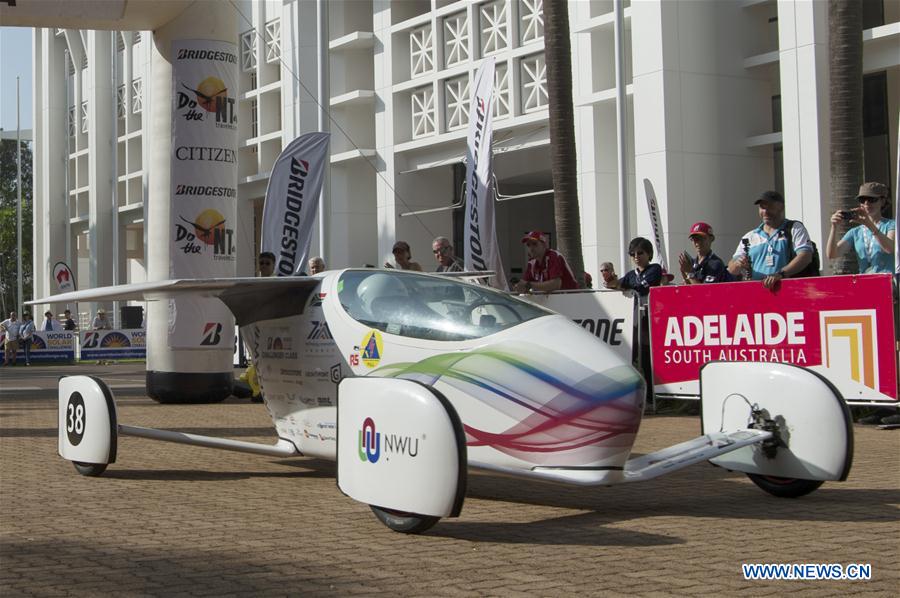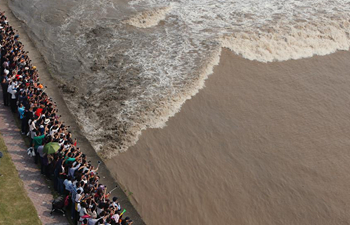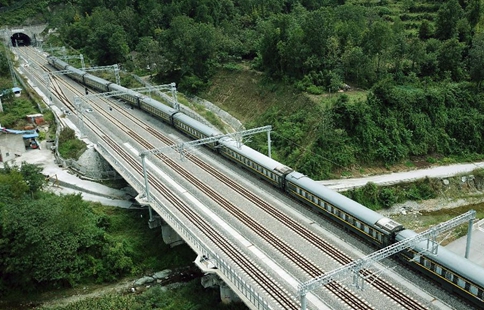
Solar car Naledi of South Africa's North-West University dashes from the starting line during the 2017 World Solar Challenge in Darwin, Australia, on Oct. 8, 2017. (Xinhua/Xu Haijing)
by Matt Walsh, Xu Haijing
DARWIN, Australia, Oct. 8 (Xinhua) -- This weekend might mark the 30th anniversary since the first running of the world's foremost solar car competition, the World Solar Challenge, but event organizers have made sure they are "still pushing boundaries" to ensure a future involving sustainable solar-powered vehicles remains a possibility.
The World Solar Challenge invites teams from around the world to Australia's notorious "outback," with team-designed solar cars challenged to make a brutal 3,000-km journey from the northern Australian city of Darwin to the southern city of Adelaide - right through the heart of Australia's desert landscape.
The biennial event, which marks its 14th crossing of Australia this year, has been crucial in raising the profile of solar car technology. With modern advancements having opened the door for mainstream electric cars, the event's director Chris Selwood said the World Solar Challenge was more important to the industry than ever before.
In an interview with Xinhua on Saturday, Selwood said the rules of the 'race' were constantly being revised to ensure that teams are being pushed to their creative limits, declaring that it would not be called a "challenge" if it was easy.
"When you push the boundaries, you're not always assured of success, and that's why it's called a challenge and not a race," Selwood told Xinhua.
"This year, we have reduced the size of the solar array from 6 square meters to 4 square meters. Paradoxically, we've also allowed the car to have a greater maximum size, and that allows the designers a whole lot more freedom to build a car within those design parameters and allows them to put a greater focus on things like aerodynamics."
Selwood said the beauty of the challenge was the sheer number of factors at play during the event; one of which being the variables posed by the weather.
"The tropical weather seems to be turning from dry season to wet season earlier than it usually does, and some people are very worried about the level of sunlight they're going to have because they've got a smaller solar panel to do the same work," Selwood said.
"It's about energy management, energy efficiency, advanced materials and advanced electronics, and it's about young people bringing their intellectual capacity and learning about new ways to do things."
Speaking in broader terms, Selwood said the challenge continues to play a vital role in mainstream automobile development, explaining that technologies first introduced in the challenge had been picked up by mainstream car manufacturers around the world, including "fast charging" and advanced diagnostics software.
"One car this year has an advanced aerodynamic coating and makes the car extremely slippery through the air which gives them a great aerodynamic advantage," he told Xinhua.
"The by-product is that dirt molecules don't adhere to it, and if we apply that to our everyday car, we'd never have to wash it."
Also involved in this year's challenge is Torsten Kupper, Huawei Germany's vice president and director of Corporate and Public Affairs. He told Xinhua that unlike in previous challenges, telcos like Huawei were crucial to the development of technologies such as autonomous driving.
"We are the biggest telecommunications company in the world, and our car is a driving computer as well. There's a lot of data we have to collect such as the heat of the motor, the heat of the asphalt, the air pressure of the tyres, so there are a lot of things which have to be monitored," Kupper said.
"Huawei is building and providing networks for autonomous driving, and there're already many manufacturers using our technology in Germany."
And while the challenge might be into its 30th year, it is just the first appearance for German team Sonnenwagen Aachen, According to second team manager, Niklas Kaltz, it has been a whirlwind experience ever since his team first decided to enter the World Solar Challenge two years ago.
"We were looking at videos from the challenge and we were fascinated by the opportunity to challenge ourselves and build a solar car from scratch," he told Xinhua.
"We didn't have a team, we didn't have much knowledge, but we were excited to do this. We discussed all aspects of the challenge, like what kind of technologies we would use and what aerodynamic shape we would choose, and eventually someone just said why don't we just do it.
"At first everyone said it was a crazy idea ... but the idea stuck with us and now we have our own solar car."
Meanwhile Selwood said the World Solar Challenge would only continue to become more important in the context of the future of the automobile industry.
"If we continue to use the fuel reserves that we've got, that's going to contribute hugely to global warming," he said.
"And instead of spending effort looking for more traditional fuels, we are looking at better ways of making our mobility a reality without it costing us the earth."
The 38 teams - classified into three groups - left Darwin on their 3000-km journey to the south Australian city of Adelaide on Sunday morning, with some teams expected to record an average speed of up to 90 km per hour throughout the challenge.















